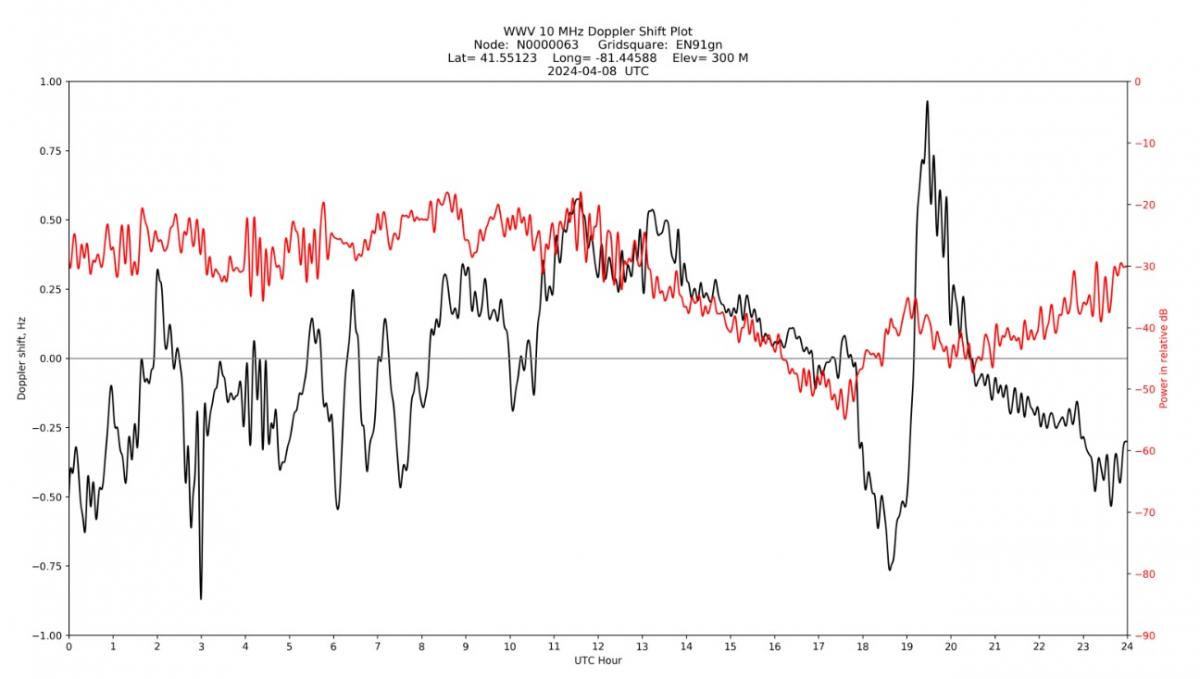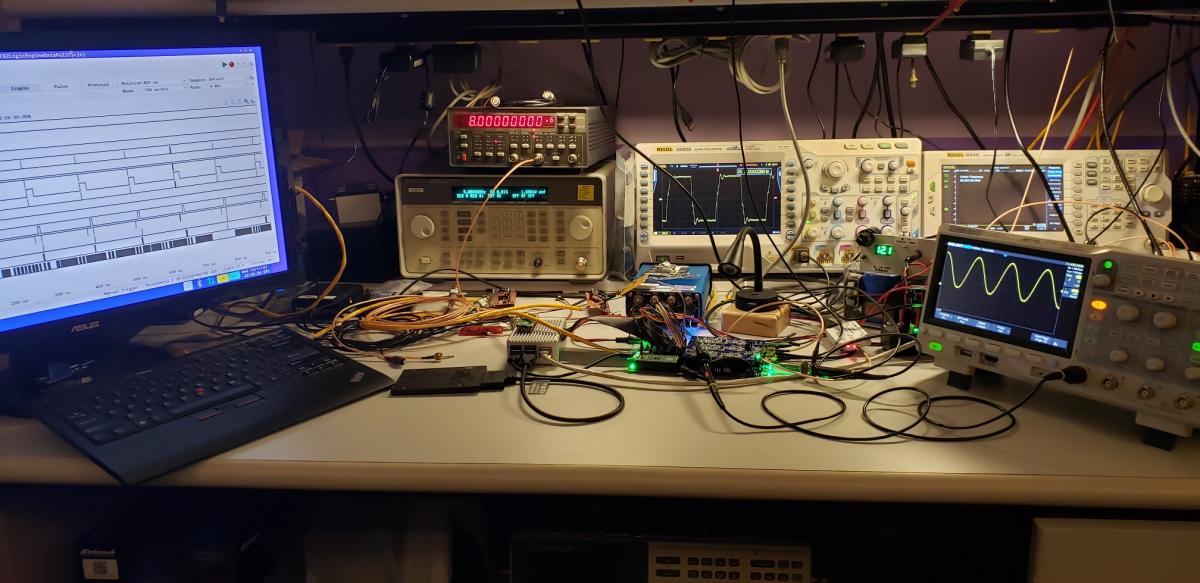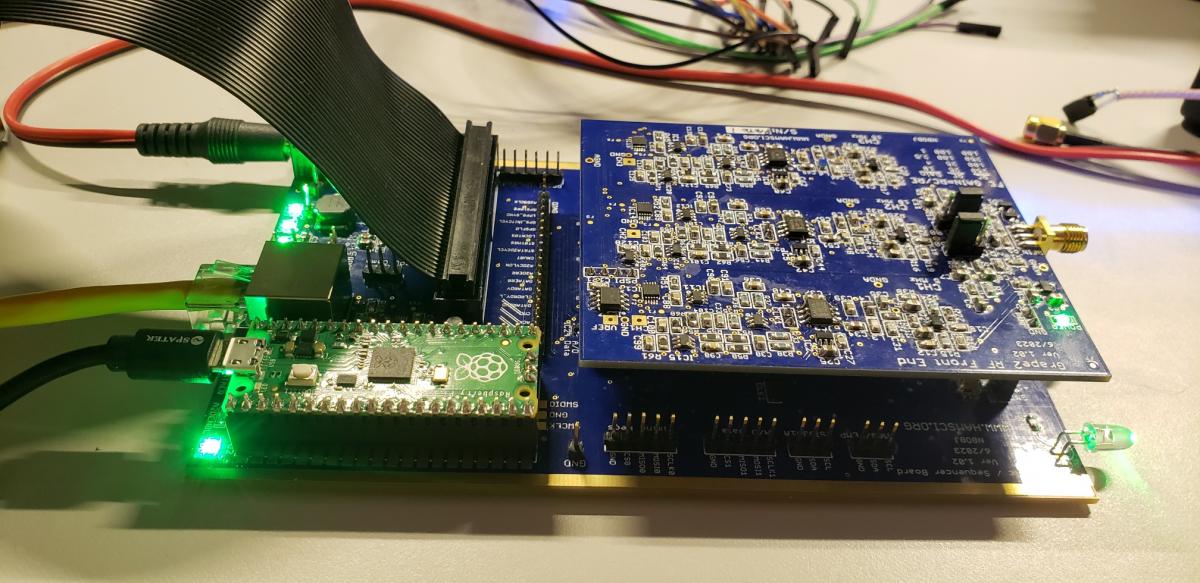GRAPE 2 fldigi - Overview, Specifications, Sourcing
 |
 |
Overview
The three-channel GRAPE 2 Doppler Monitor (fldigi version) is a key component of the HamSCI Personal Space Weather Station (PSWS). It could be considered the 'next generation' of GRAPE receiver, released just prior to the April 8, 2024 North American solar Eclipse. It is used for receiving, analyzing and recording of signals from frequency standard stations such as WWV/H and CHU. The PSWS project involves monitoring changes in the Earth's ionosphere through measurements of Doppler frequency shifts on a 24/7 basis.
The Grape 2 could be considered the 'big brother' of the GRAPE PSWS family. It is capable of receiving three frequencies simultaneously, utilizing a GPS disciplined oscillator for making precise frequency measurements. A complete GRAPE 2 PSWS system (as pictured above) consists of the following: Grape 2 Receiver and Logic PC boards, Teensy microcontroller, Raspberry Pi 4, external hard drive, power supply and two antennas, one for the GPS and one for the time standard frequencies. Ideally, every Grape 2 should have access to a reasonably fast (>100Mb/S) Internet connection for data uploads. There is a provision to buffer and transmit buffered data at a later time if the connection is lost. Data collected by the GRAPE 2 is intended to be uploaded on a daily basis to a HamSCI server. The data collected by a Grape 2 can be used to generate plots of Doppler shift vs. UTC hour. A sample plot from April 8, 2024 (the date of the recent North American total solar eclipse) appears above. (The solar eclipse's effect on the ionosphere is clearly visible between about 1800 and 2100 UTC.)
Specifications
| Purpose | Three frequency, low-IF receiver, used for measuring Doppler shift while receiving frequency standard stations such as WWV/H or CHU. Data is useful for studying bottom side motion of the ionosphere. |
| Frequency Selections | 2.5, 5.0, 10.0 or 15.0 MHz (reduced though very acceptable performance on 3.33, 7.58 or 14.36 MHz) |
| Frequency Stability | As stable as the Leo Bodnar GPS disciplined oscillator, approaching 1x10-12 |
| Sensitivity | Under review |
| Dynamic Range | Under review |
| Received Bandwidth | Under review |
| Current Hardware Version | 1.0. No further revisions or production is planned. |
| Required Computer | Raspberry Pi 4B, 8 GB memory |
| Operating System | Raspbian OS |
| Required software | fldigi, a ham radio modem application, numerous GRAPE-specific shell scripts |
| Data Repository | The GRAPE 2 fldigi data is freely accessible, available in the HamSCI Community on Zenodo.org |
Grape 2 User Manual
The Grape 2 User Manual Version 1.2 was sent out in March of 2024, as part of the original deployment. It can be found here on the HamSCI website.
Sourcing
Approximately 30 GRAPE 2s were manufactured and tested late in Q1, 2024. They were deployed in accordance with terms of the grants which funded the project: A map of the stations appears on this page. They were on line and uploading data during the April 8, 2024 North American total solar eclipse. It is HamSCI's expectation that all will be kept running, on a 24/7/365 basis, for years to come, studying the behavior of the ionosphere during Solar Cycle 25. Further, some GRAPE 2 installations included remote magnetometer boards, used to measure minute changes in the Earth's magnetic field. That data was sent to the same HamSCI server.
Occasionally, units are returned to HamSCI for redeployment. If you are interested in hosting a grand-funded GRAPE 2, please send your contact info, including location (grid square and city/state/province) to hamsci@hamsci.org. Note that grantees are expected to have basic Linux experience, an HF (shortwave) antenna, and common computing peripherals (USB keyboard/mouse, monitor) and an Internet connection for daily data uploads. Of course, we can't guarantee availability but we are very interested in having as many systems running as possible.
Grape 2 Update - Disk Drive Swap - March/April, 2025
While some data was uploaded to HamSCI data collection servers on a daily basis (a very narrow band of digitized audio, centered 1 kHz below the three time station carriers received) a great deal more data (~3KHz bandwidth, ~10.4GB per day) was captured and stored locally on each Grape 2's hard drive. The 4TB drives are filling up, so new drives are being provided to each Grape 2 host. We ask that you follow this procedure to make the swap. Questions are best raised to the HamSCI Grape Google Group. Provisions have been made for hosts to ship the old drives to the University of Alabama, where the data will be extracted and uploaded to the PSWS Central Control System.
Further Information
- Support is available from the HamSCI-psws Google Group. All are welcome to join, ask questions, assist others on their GRAPE journeys.
- HamSCI explains The Science Behind the Grape Doppler Monitor
- In mid-October, 2023, while an annular solar eclipse which transited North and South America, over 50 GRAPE 1 systems were in operation, uploading research-worthy data. The GRAPE project contributors from that time period are noted on the GRAPE 1 Recognition and Acknowledgement page.
- The GRAPE 1 is just one module of the HamSCI Personal Space Weather Station (PSWS) Learn more here: Overview of the Personal Space Weather Station (PSWS)
Images of the Grape 2 under development at the bench of John Gibbons, N8OBJ:
 |
 |
Grape 2 Hosts
30 Grape Version 2s were deployed prior to the April 8, 2024 total solar eclipse over North America. The host stations are shown on this map.
Credits
The Grape Version 2 was designed by John Gibbons, N8OBJ, Lab Director of the Sears Undergraduate Electrical Design Lab, Case Western Reserve University, Department of Electrical Engineering. Software applications were written by Bill Blackwell, AB1XB and Cuong Nguyen, KC3UAX. The remote magnetometer board was designed, built and provided to host stations by David Witten, KD0EAG. Dr. Nathaniel Frissell, W2NAF, was the Principal Investigator on National Science Foundation grant 2230345 ('Collaborative Research: CEDAR: Measuring Daily Ionospheric Variability and the 2023 & 2024 Solar Eclipse Ionospheric Impacts Using HamSCI HF Doppler Shift Receivers'). Their efforts were supported by additional NSF grants (2002278, 1922972, 1932997, 2230346) and these institutions:

17 October 2025: Updated PSWS CCS URL - af8a
